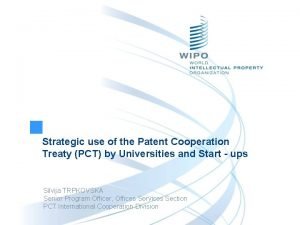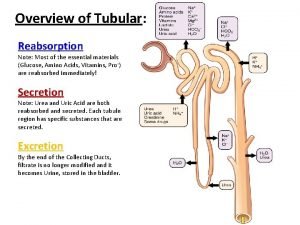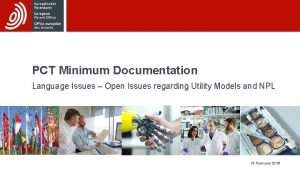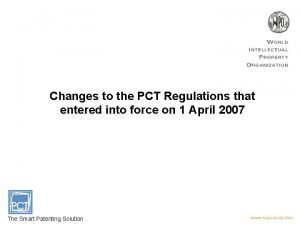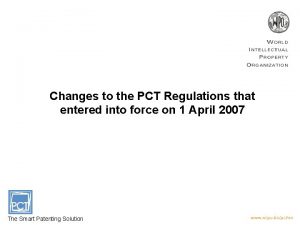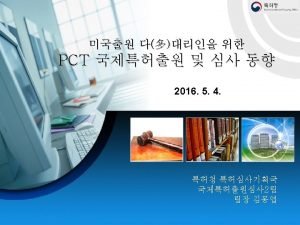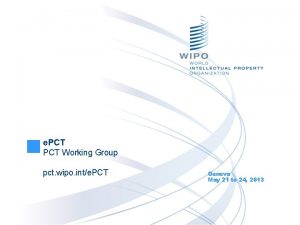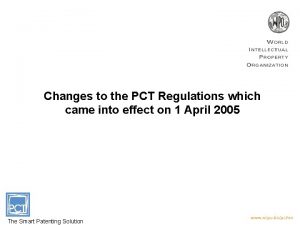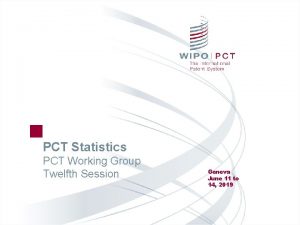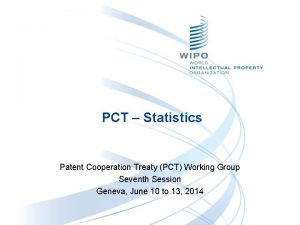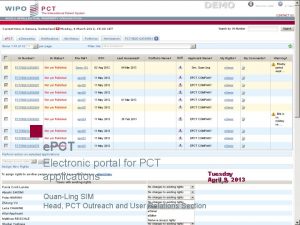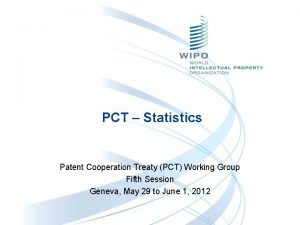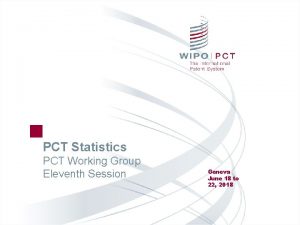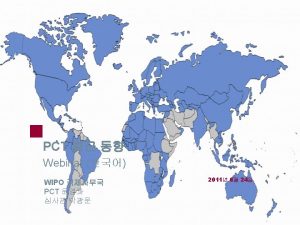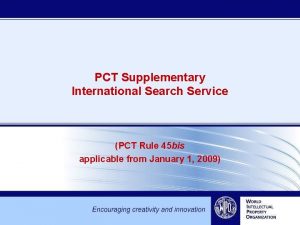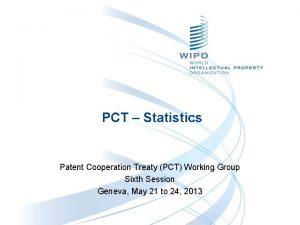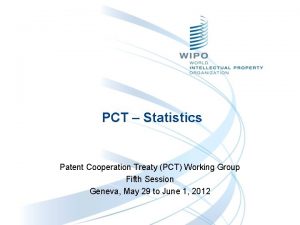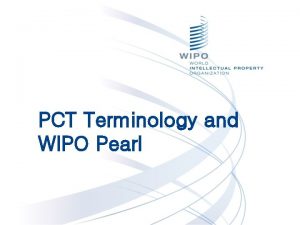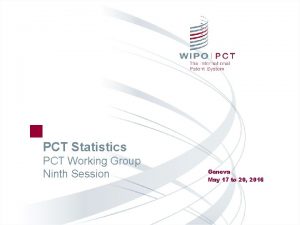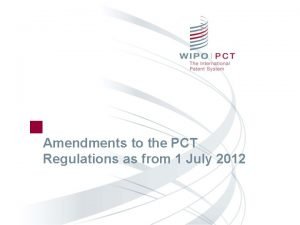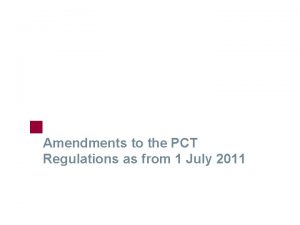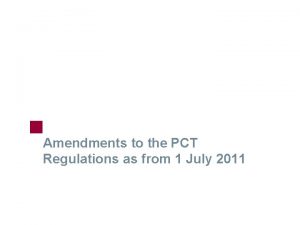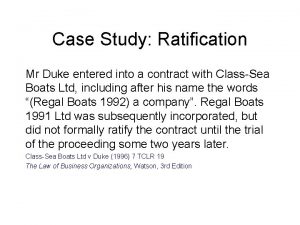Changes to the PCT Regulations that entered into
























- Slides: 24

Changes to the PCT Regulations that entered into force on 1 April 2007 The Smart Patenting Solution

Main changes to the PCT Regulations that entered into force on 1 April 2007 · Missing elements and parts of the international application · Restoration of the right of priority · Rectification of obvious mistakes · Physical requirements · Correction procedure · PCT minimum documentation: Addition of patent documents of the Republic of Korea · Minimum requirements for ISAs

Relevant documents • Amendments adopted by the 2005 PCT Assembly, see document PCT/A/34/6 (report) at: www. wipo. int/edocs/mdocs/govbody/en/pct_a_34_6. doc • Amendments adopted by the 2006 PCT Assembly, see document PCT/A/35/7 at: www. wipo. int/edocs/mdocs/pct/en/pct_a_35_7. doc • Consolidated text of the Regulations under the PCT, as in force from 1 April 2007 at: www. wipo. int/pct/en/texts/pdf/pct_regs_april_2007. pdf

Missing elements and parts of the international application (Rule 20) • Objective: Enable inclusion of accidentally omitted elements or parts that are contained in a priority application without affecting the international filing date – element = all of the description or all of the claims – part = part of the description, part of claims or part or all of pages of drawings • Conditions: – priority application contains the element or part (Rule 20. 6(b)) – request contains statement of (conditional) incorporation by reference (Rule 4. 18) – timely confirmation of incorporation by reference (Rules 20. 6 and 20. 7) • Competent Authority: RO

Confirmation of incorporation by reference (1) (Rules 20. 6 and 20. 7) • Time limit: two months from filing or from invitation to correct (Rule 20. 7) • Documents to be filed (Rule 20. 6): – notice of confirmation – missing sheets – copy of the earlier application as filed unless the priority document already submitted – translation if not in the language of the international application – indication as to where in the priority document (and translation) the missing parts are contained

Confirmation of incorporation by reference (2) (Rules 20. 6 and 20. 7) • If not all requirements for incorporation by reference are fulfilled (for example, if a missing element or part is not entirely contained in the earlier application): – the international application is assigned a later filing date (date of receipt of missing element or part), – applicant may request that missing part be disregarded (Rule 20. 5(e))

Invitation by RO to correct defect under Article 11(1) (Rule 20. 3) Where the entire description or all claims are missing, RO invites the applicant to either: • furnish a correction under Article 11(2) and the international application is accorded a later filing date or, • confirm under Rule 20. 6(a) that the element is incorporated by reference under Rule 4. 18 and the international filing date is maintained

Effect of incorporation by reference in the national phase (Rule 82 ter. 1(b)) • DOs may, to a limited extent, review the decision allowing the incorporation by reference • Declarations of incompatibility with the national law (reservations) were made by a number of ROs and DOs See WIPO website at: www. wipo. int/pct/en/texts/reservations/res_incomp. pdf

Incorporation by reference Declarations of incompatibility with the national law The following Offices have notified the International Bureau of the incompatibility of Rules 20. 3(a)(ii) and (b)(ii), 20. 5(a)(ii) and (d), and 20. 6 with its national/regional law: • Incompatibility as RO (Rule 20. 8(a)): BE, CU, CZ, DE, EP, ES, HU, ID, IT, JP, KR, MX, PH • Incompatibility as DO (Rule 20. 8(b)): CN, CU, CZ, DE, EP, ES, HU, ID, JP, KR, LT, MX, PH, TR

Restoration of the right of priority (Rule 26 bis. 3) • Objective: Allow a priority claim to an earlier filed application even if the international application is filed outside the priority year • Conditions: – – request must be filed with the RO maximum extension of priority period: two months statement of reasons for failure to comply with the time limit preferably accompanied by a declaration or other evidence to support such statement – where applicable, payment of the required fee

Restoration of the right of priority Competent authorities (Rules 26 bis. 3 and 49 ter. 2) • Competent Authorities: – RO during the international phase – DO during the national phase

Restoration of the right of priority Applicable criteria (Rules 26 bis. 3 and 49 ter. 2) Two possible criteria for restoration: 1. failure to file the application within the priority period occurred in spite of due care required by the circumstances having been taken 2. period failure to file the application within the priority was unintentional All Offices must apply at least one of these criteria and may apply both; designated Offices may also apply a more favorable criterion in accordance with their national law

Restoration of the right of priority General principles (Rule 26 bis. 3) • Any priority claim to an earlier application filed less than 14 months before the international filing date – will remain in the application even if priority is not restored by the RO (Rule 26 bis. 2(c)(iii)) – will serve as a basis to calculate time limits during the international phase • The validity of such a priority claim in the national phase is not assured • ROs may require a declaration or other evidence and a fee

Restoration of the right of priority Effect in the national phase (Rule 49 ter) • Effect of RO restoration in the national phase: – RO restoration based on the “due care” criterion is effective in all DOs – RO restoration based on the “unintentional” criterion is effective in those DOs which apply that criterion (or a more lenient one) – RO restoration is not conclusively binding on DOs: limited review by DOs is possible – RO refusal to restore is not binding on DOs • Declarations of incompatibility with the national law (reservations) were made by a number of ROs and DOs See the WIPO website at: www. wipo. int/pct/en/texts/reservations/res_incomp. pdf

Restoration of the right of priority Reservations made by Offices The following Offices have notified the International Bureau of the incompatibility of Rule 26 bis. 3(a) to (i), Rule 49 ter. 1(a) to (d) and/or Rule 49 ter. 2(a) to (g) with their national/regional law: • Incompatibility as RO (Rule 26 bis. 3(j)): BE, BR, CO, CU, CZ, DE, DZ, EP, ES, FR, GR, HU, ID, IN, IT, JP, KR, NO, PH, PT • Incompatibility of the effect of decision of RO on DO (Rule 49 ter. 1(g)): BR, CA, CN, CO, CU, CZ, DE, DZ, EP, ES, HU, ID, IN, JP, KR, LT, MX, NO, PH, PT, SE, * TR, US • Incompatibility as DO (Rule 49 ter. 2(h)): BR, CA, CN, CO, CU, CZ, DE, DZ, EP, ES, HU, ID, IN, JP, KR, LT, MX, NO, PH, PT, SE, * TR, US * Notification withdrawn effective 1 July 2007

Related issues concerning priority claims • Any correction of a priority claim received before the RO or IB has declared the priority claim to be void and not later than one month after the expiration of the applicable time limit under Rule 26 bis. 1(a), will be considered as timely received (Rule 26 bis. 2(b)) NOTE: This does not apply to late additions of priority claims • Obvious mistakes in priority claims may only be rectified through Rule 91 if the rectification would not cause a change in the priority date (Rule 91. 1(g)(iv)) • Information about a priority claim considered void or only not declared void because of the operation of Rule 26 bis. 2(c) (missing number, inconsistency with priority document, international filing date within two months from the end of the priority period) and any information submitted by the applicant concerning such priority claims will be published by the IB free of charge (Rule 26 bis. 2(d)) • If the applicant wishes to correct or add a priority claim after the time limit has expired, the IB will, at the applicant’s request and subject to the payment of a fee, publish information concerning the matter (Rule 26 bis. 2(e))

Rectification of obvious mistakes (1) (Rule 91) Main changes in the redrafted Rule: – former “obvious error” becomes “obvious mistake” – mistake must now only be obvious to “the competent Authority” and no longer to “anyone” – new time limit: request for rectification must be submitted within 26 months from the priority date

Rectification of obvious mistakes (2) (Rule 91) • Clarification as to mistakes which are not rectifiable under Rule 91: – missing pages and parts – mistake in the abstract – mistake in Article 19 amendments – mistake in the priority claims • DO may disregard a rectification “if it finds that it would not have authorized the rectification if it had been the competent authority”, but must give the applicant an opportunity to make observations (Rule 91. 3(f))

Rectification of obvious mistakes (3) (Publication, Rule 48. 2) Authorized request for rectification: – if this is received after technical preparations for publication have been completed, the IB will publish a statement reflecting the rectifications, any replacement sheets and the request for rectification together with the republished front page (Rule 48. 2(i)) Refused request for rectification: – this will be published, upon request by the applicant within two months from the refusal and against payment of a fee, together with the reasons for refusal and any brief comments by applicant (Rule 91. 3(d)); if this is received after technical preparations for publication have been completed, it will be promptly published with the republished front page (Rule 48. 2(k))

Physical requirements (Rule 11. 9(d)) Size of characters: All text matter in the international application should be in characters the capital letters of which are not less than 0. 28 cm high (new) Text matter in the request may be in characters the capital letters of which are not less than 0. 21 cm high (unchanged)

Correction procedure (Rule 26. 4) Correction in the request : – may be stated in a letter Correction of any element of the international application other than the request : – replacement sheet and letter drawing attention to the differences between the replaced and the replacement sheet must be submitted

PCT minimum documentation: addition of patent documents of the Republic of Korea (Rule 34) • Patent documents of the Republic of Korea will be included in the PCT minimum documentation used by ISAs in carrying out international searches • ISAs whose official language is not Korean are only obliged to include in their documentation those patent documents for which an English abstract is available • The Office of the Republic of Korea is making such English abstracts available • Although the amendment will only enter into force on 1 April 2007, the ISAs have indicated that they will be ready to use patent documents of the Republic of Korea as of 1 January 2007 (or earlier for many ISAs)

Minimum requirements for ISAs/IPEAs (Rules 36 and 63) Additional requirement: – the Office must have in place a quality management system and internal review arrangements according to the common rules of international search and international preliminary examination; for further details, see PCT International Search and Preliminary Examination Guidelines, Chapter 21, A Common Quality Framework for International Search and Preliminary Examination

Entry into force; transitional arrangements • Generally, all amendments will apply to international applications filed on or after 1 April 2007 • Exceptions: see Annex III of document PCT/A/34/6 at: www. wipo. int/edocs/mdocs/govbody/en/pct_a_34_6. doc and Annex III of document PCT/A/35/7 at: www. wipo. int/edocs/mdocs/pct/en/pct_a_35_7. doc
 Data or instructions entered into the computer
Data or instructions entered into the computer Enter quietly
Enter quietly Made an agreement
Made an agreement Tìm vết của đường thẳng
Tìm vết của đường thẳng Sau thất bại ở hồ điển triệt
Sau thất bại ở hồ điển triệt Thể thơ truyền thống
Thể thơ truyền thống Hãy nói thật ít để làm được nhiều
Hãy nói thật ít để làm được nhiều Thơ thất ngôn tứ tuyệt đường luật
Thơ thất ngôn tứ tuyệt đường luật Tôn thất thuyết là ai
Tôn thất thuyết là ai Phân độ lown
Phân độ lown Chiến lược kinh doanh quốc tế của walmart
Chiến lược kinh doanh quốc tế của walmart Gây tê cơ vuông thắt lưng
Gây tê cơ vuông thắt lưng Block av độ 1
Block av độ 1 Elizabeth mulroney
Elizabeth mulroney Example of physical and chemical change
Example of physical and chemical change Pct working
Pct working Positive personal profile
Positive personal profile Dr scally power pct
Dr scally power pct Pct portal
Pct portal Pct example
Pct example Reabsorption
Reabsorption Wirral primary care trust
Wirral primary care trust Pct minimum documentation
Pct minimum documentation Pct rule 91
Pct rule 91 Procalcitonin là gì
Procalcitonin là gì



















